2018 TOYOTA YARIS iA child restraint
[x] Cancel search: child restraintPage 58 of 576
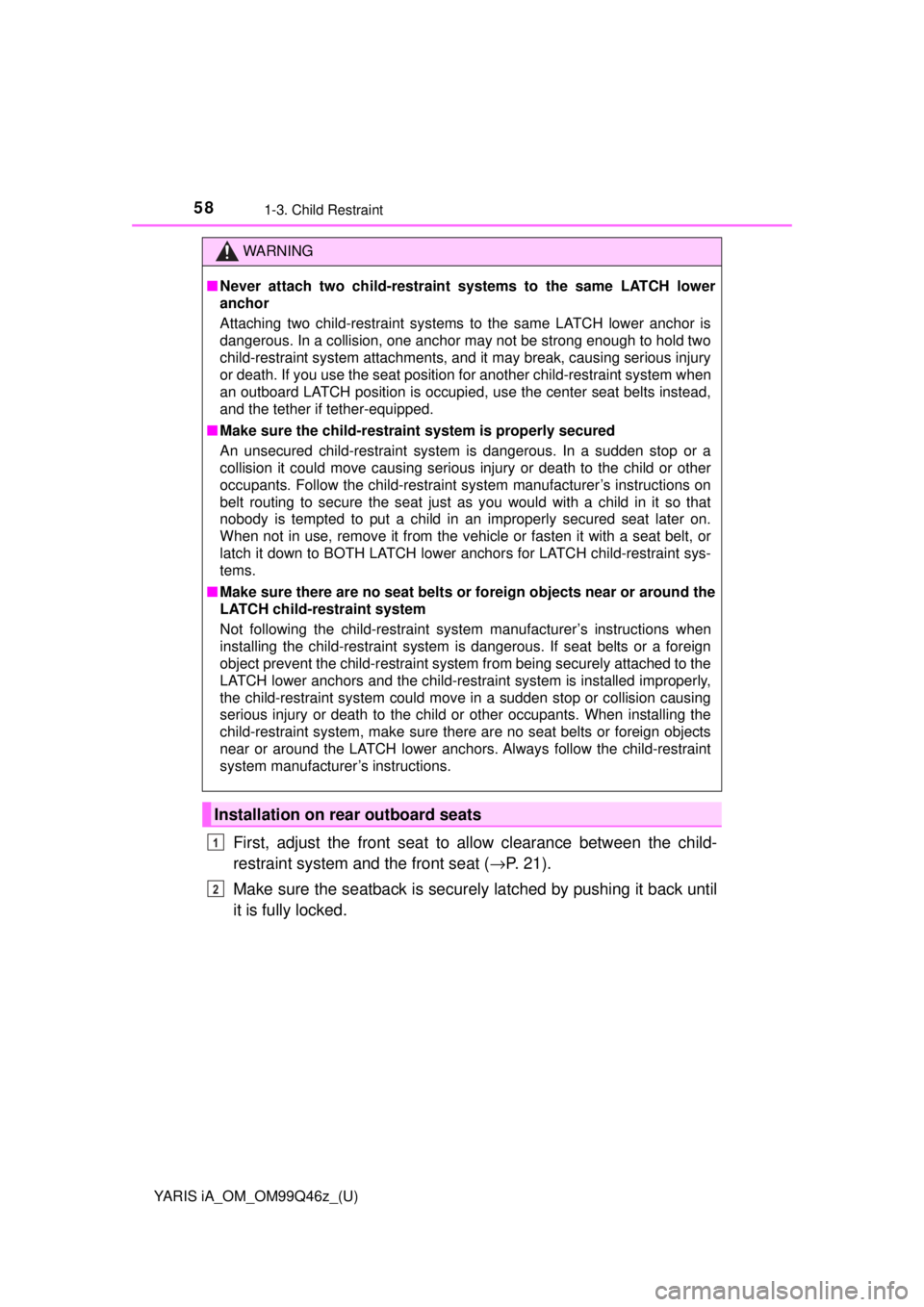
58
YARIS iA_OM_OM99Q46z_(U)
1-3. Child Restraint
First, adjust the front seat to allow clearance between the child-
restraint system and the front seat ( →P. 2 1 ) .
Make sure the seatback is securely latched by pushing it back until
it is fully locked.
WARNING
■ Never attach two child-restraint systems to the same LATCH lower
anchor
Attaching two child-restraint systems to the same LATCH lower anchor is
dangerous. In a collision, one anchor may not be strong enough to hold two
child-restraint system attachments, and it may break, causing serious injury
or death. If you use the seat position for another child-restraint system when
an outboard LATCH position is occupied, use the center seat belts instead,
and the tether if tether-equipped.
■ Make sure the child-restraint system is properly secured
An unsecured child-restraint system is dangerous. In a sudden stop or a
collision it could move causing serious injury or death to the child or other
occupants. Follow the child-restraint system manufacturer’s instructions on
belt routing to secure the seat just as you would with a child in it so that
nobody is tempted to put a child in an improperly secured seat later on.
When not in use, remove it from the vehicle or fasten it with a seat belt, or
latch it down to BOTH LATCH lower anchors for LATCH child-restraint sys-
tems.
■ Make sure there are no seat belts or foreign objects near or around the
LATCH child-restraint system
Not following the child-restraint system manufacturer’s instructions when
installing the child-restraint system is dangerous. If seat belts or a foreign
object prevent the child-restraint system from being securely attached to the
LATCH lower anchors and the child-restraint system is installed improperly,
the child-restraint system could move in a sudden stop or collision causing
serious injury or death to the child or other occupants. When installing the
child-restraint system, make sure there are no seat belts or foreign objects
near or around the LATCH lower anchors. Always follow the child-restraint
system manufacturer’s instructions.
Installation on rear outboard seats
1
2
Page 59 of 576

YARIS iA_OM_OM99Q46z_(U)
591-3. Child Restraint
1
Essential Safety Equipment
Expand the open seams on the
rear of the seat bottom slightly
to verify the locations of the
LATCH lower anchors.
The markings above the LATCH
lower anchors indicate the loca-
tions of the LATCH lower anchors
for the attachment of a child-
restraint system.
Remove the head restraint.
Refer to Head Restraints on P. 27.
Secure the child-restraint system using BOTH LATCH lower
anchors, following the child-restraint system manufacturer’s instruc-
tion. Pull on the child-restraint to be sure both anchors are
engaged.
If your child-restraint system came equipped with a tether, that
means it is very important to pr operly secure the tether for child
safety. Please carefully follow the child-restraint system manufac-
turer’s instructions when installing tethers.
3
WARNING
■ Use the tether and tether anchor only for a child-restraint system
Using the tether or tether anchor to secure anything but a child-restraint
system is dangerous. This could weaken or damage the tether or tether
anchor and result in injury.
■ Always remove the head restraint and install child-restraint system
4
5
6
Installing a child-restraint system without
removing the head restraint is danger-
ous. The child-restraint system cannot be
installed correctly which may result in
death or injury to the child in a collision.
Anchor bracket
Tether strap
Page 60 of 576
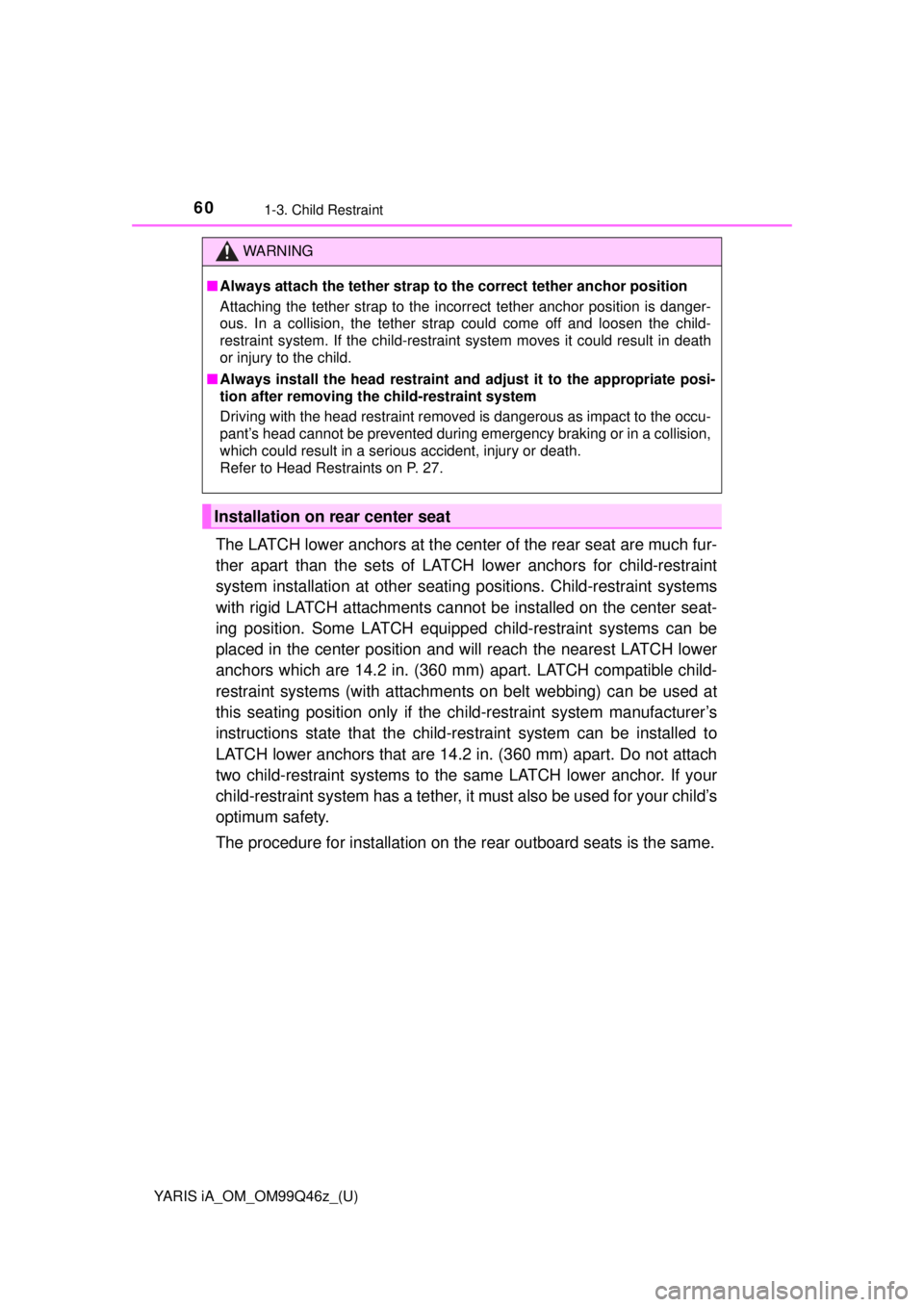
60
YARIS iA_OM_OM99Q46z_(U)
1-3. Child Restraint
The LATCH lower anchors at the center of the rear seat are much fur-
ther apart than the sets of LATCH lower anchors for child-restraint
system installation at other seating positions. Child-restraint systems
with rigid LATCH attachments cannot be installed on the center seat-
ing position. Some LATCH equipped child-restraint systems can be
placed in the center position and will reach the nearest LATCH lower
anchors which are 14.2 in. (360 mm) apart. LATCH compatible child-
restraint systems (with attachments on belt webbing) can be used at
this seating position only if the ch ild-restraint system manufacturer’s
instructions state that the child-res traint system can be installed to
LATCH lower anchors that are 14.2 in. (360 mm) apart. Do not attach
two child-restraint systems to the same LATCH lower anchor. If your
child-restraint system has a tether, it must also be used for your child’s
optimum safety.
The procedure for installation on the rear outboard seats is the same.
WARNING
■ Always attach the tether strap to the correct tether anchor position
Attaching the tether strap to the incorrect tether anchor position is danger-
ous. In a collision, the tether strap could come off and loosen the child-
restraint system. If the child-restraint system moves it could result in death
or injury to the child.
■ Always install the head restraint and adjust it to the appropriate posi-
tion after removing the child-restraint system
Driving with the head restraint removed is dangerous as impact to the occu-
pant’s head cannot be prevented during emergency braking or in a collision,
which could result in a serious accident, injury or death.
Refer to Head Restraints on P. 27.
Installation on rear center seat
Page 61 of 576
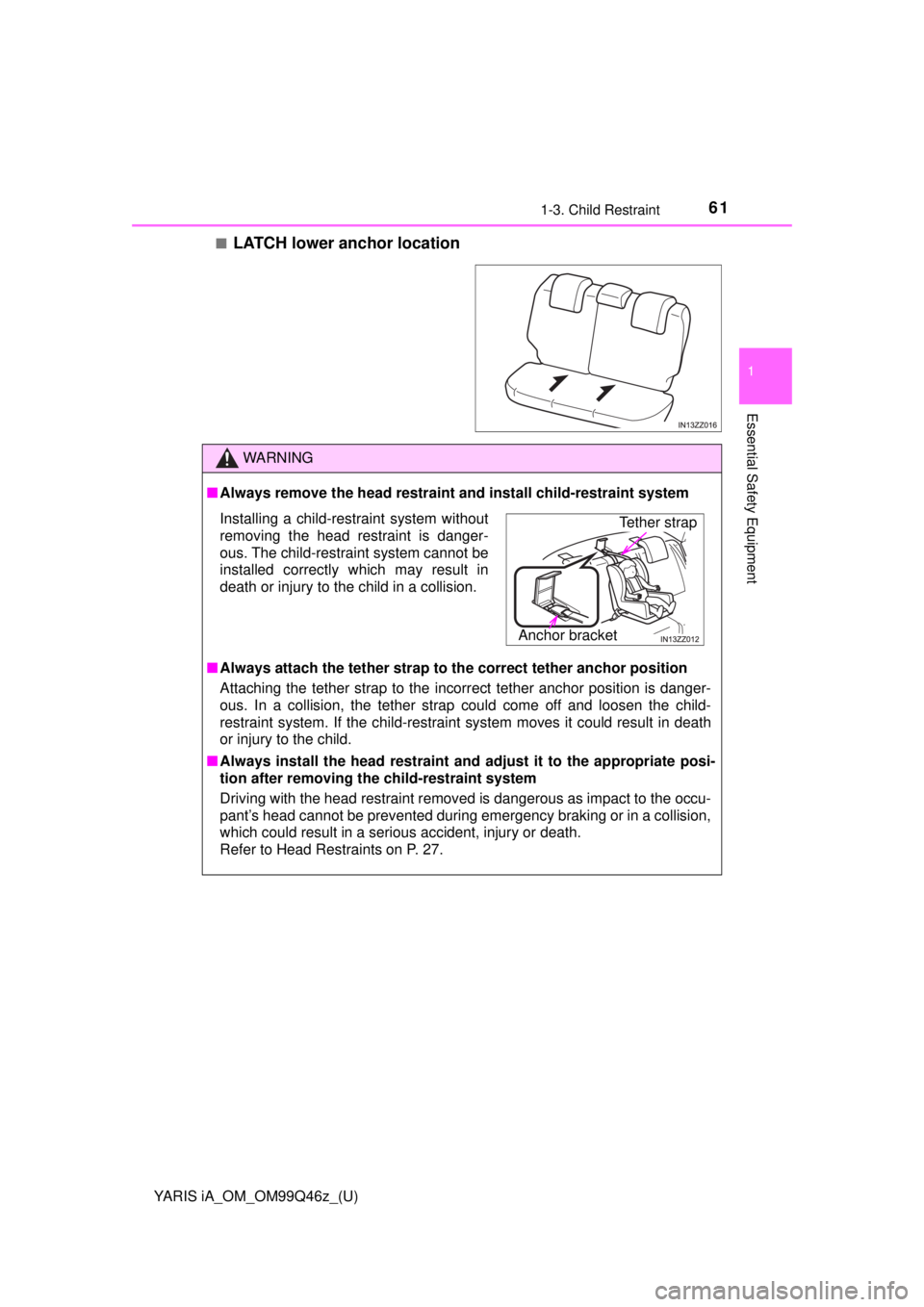
YARIS iA_OM_OM99Q46z_(U)
611-3. Child Restraint
1
Essential Safety Equipment
■LATCH lower anchor location
WARNING
■Always remove the head restraint and install child-restraint system
■ Always attach the tether strap to the correct tether anchor position
Attaching the tether strap to the incorrect tether anchor position is danger-
ous. In a collision, the tether strap could come off and loosen the child-
restraint system. If the child-restraint system moves it could result in death
or injury to the child.
■ Always install the head restraint and adjust it to the appropriate posi-
tion after removing the child-restraint system
Driving with the head restraint removed is dangerous as impact to the occu-
pant’s head cannot be prevented during emergency braking or in a collision,
which could result in a serious accident, injury or death.
Refer to Head Restraints on P. 27.
Installing a child-restraint system without
removing the head restraint is danger-
ous. The child-restraint system cannot be
installed correctly which may result in
death or injury to the child in a collision.
Anchor bracket
Tether strap
Page 63 of 576
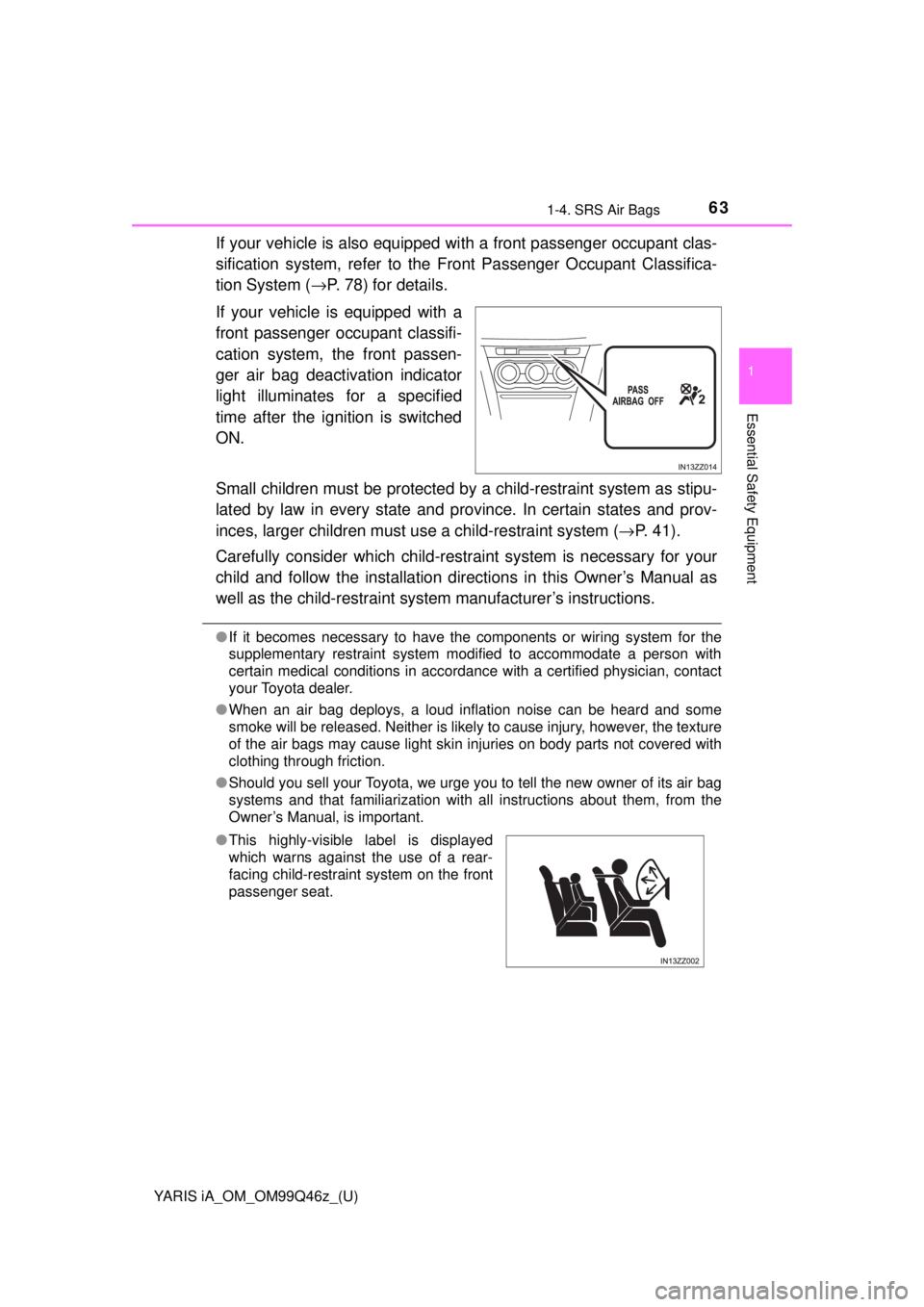
YARIS iA_OM_OM99Q46z_(U)
631-4. SRS Air Bags
1
Essential Safety Equipment
If your vehicle is also equipped with a front passenger occupant clas-
sification system, refer to the Fr ont Passenger Occupant Classifica-
tion System ( →P. 78) for details.
If your vehicle is equipped with a
front passenger occupant classifi-
cation system, the front passen-
ger air bag deactivation indicator
light illuminates for a specified
time after the ignition is switched
ON.
Small children must be protected by a child-restraint system as stipu-
lated by law in every state and prov ince. In certain states and prov-
inces, larger children must us e a child-restraint system (→P. 4 1 ) .
Carefully consider whic h child-restraint system is necessary for your
child and follow the installation directions in this Owner’s Manual as
well as the child-restraint syst em manufacturer’s instructions.
●If it becomes necessary to have the components or wiring system for the
supplementary restraint system modified to accommodate a person with
certain medical conditions in accordance with a certified physician, contact
your Toyota dealer.
● When an air bag deploys, a loud inflation noise can be heard and some
smoke will be released. Neither is likely to cause injury, however, the texture
of the air bags may cause light skin injuries on body parts not covered with
clothing through friction.
● Should you sell your Toyota, we urge you to tell the new owner of its air bag
systems and that familiarization with all instructions about them, from the
Owner’s Manual, is important.
●This highly-visible label is displayed
which warns against the use of a rear-
facing child-restraint system on the front
passenger seat.
Page 64 of 576

64
YARIS iA_OM_OM99Q46z_(U)
1-4. SRS Air Bags
WARNING
■Seat belts must be worn in air bag equipped vehicles
Depending only on the air bags for protection during an accident is danger-
ous. Alone, air bags may not prevent serious injuries. The appropriate air
bags can be expected to inflate only in the first accident, such as frontal,
near frontal or side collisions or roll-over accidents that are at least moder-
ate. Vehicle occupants should always wear seat belts.
■ Children should not ride in the front passenger seat
Placing a child, 12 years or under, in the front seat is dangerous. The child
could be hit by a deploying air bag and be seriously injured or even killed. A
sleeping child is more likely to lean against the door and be hit by the side
air bag in moderate collision to the front-passenger side of the vehicle.
Whenever possible, always secure a child 12 years and under on the rear
seats with an appropriate child-restraint system for the child’s age and size.
■ Never use a rear-facing child-restra int system in the front seat with an
air bag that could deploy
■ Do not sit too close to the dr iver and front passenger air bags
Sitting too close to the driver and fr ont passenger air bag modules or plac-
ing hands or feet on them is extremely dangerous. The driver and front pas-
senger air bags inflate with great force and speed. Serious injuries could
occur if someone is too close. The driver should always hold onto only the
rim of the steering wheel. The front seat passenger should keep both feet
on the floor. Front seat occupants should adjust their seats as far back as
possible and always sit upright against the seatbacks with seat belts worn
properly.
Rear-facing child-restraint systems on
the front seat are particularly dangerous
even though you may feel assured that a
front passenger air bag will not deploy
based on the fact that the front passen-
ger air bag deactivation indicator light
illuminates. The child-restraint system
can be hit by a deploying air bag and
moved violently backward resulting in
serious injury or death to the child.
Page 79 of 576
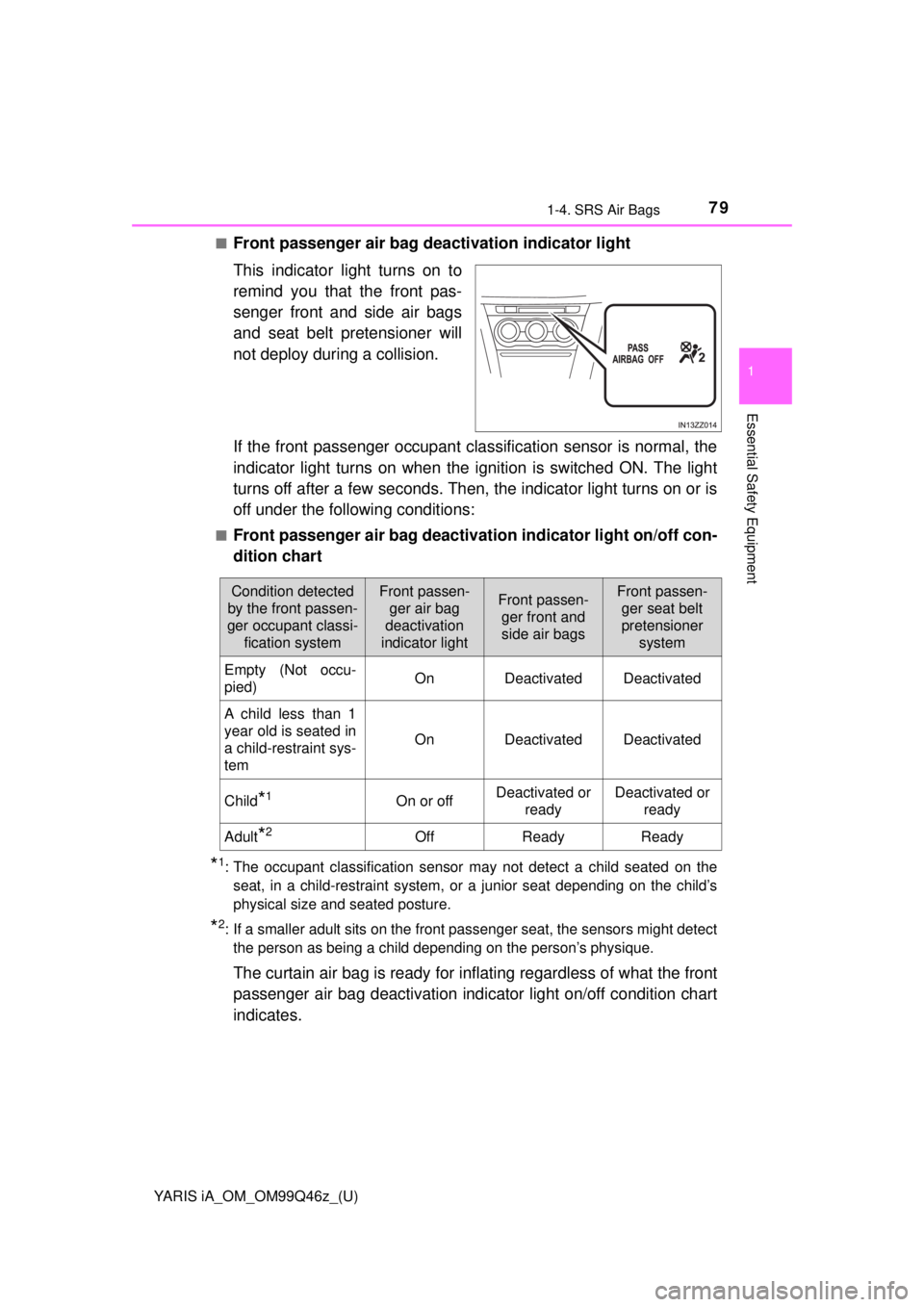
YARIS iA_OM_OM99Q46z_(U)
791-4. SRS Air Bags
1
Essential Safety Equipment
■Front passenger air bag deactivation indicator light
This indicator light turns on to
remind you that the front pas-
senger front and side air bags
and seat belt pretensioner will
not deploy during a collision.
If the front passenger occupant classification sensor is normal, the
indicator light turns on when the ignition is switched ON. The light
turns off after a few seconds. Then, the indicator light turns on or is
off under the following conditions:
■Front passenger air bag deactivat ion indicator light on/off con-
dition chart
*1: The occupant classification sensor may not detect a child seated on the seat, in a child-restraint system, or a junior seat depending on the child’s
physical size and seated posture.
*2: If a smaller adult sits on the front passenger seat, the sensors might detectthe person as being a child depending on the person’s physique.
The curtain air bag is ready for inflating regardless of what the front
passenger air bag deactivation indi cator light on/off condition chart
indicates.
Condition detected
by the front passen-
ger occupant classi-
fication systemFront passen-ger air bag
deactivation
indicator lightFront passen- ger front and
side air bagsFront passen- ger seat belt
pretensioner
system
Empty (Not occu-
pied)OnDeactivatedDeactivated
A child less than 1
year old is seated in
a child-restraint sys-
tem
OnDeactivatedDeactivated
Child*1On or offDeactivated or readyDeactivated or ready
Adult*2OffReadyReady
Page 80 of 576

80
YARIS iA_OM_OM99Q46z_(U)
1-4. SRS Air Bags
If the front passenger air bag deactivation indicator light does not
turn on when the ignition is switched ON and does not turn on as
indicated in the front passenger air bag deactivation indicator light
on/off condition chart, do not allow an occupant to sit in the front
passenger seat and consult your To yota dealer as soon as possi-
ble. The system may not work properly in an accident.
●The system requires about 10 seconds to alternate between turning the
front passenger front and side air bags and seat belt pretensioner system on
or off.
● The front passenger air bag deactivation indicator light may turn on repeat-
edly if luggage or other items are put on the front passenger seat, or if the
temperature of the vehicle’s interior changes suddenly.
● The front passenger air bag deactivation indicator light may turn on for 10
seconds if the electrostatic capacity on the front passenger seat change\
s.
● The air bag/front seat belt pretensioner system warning light might turn on if
the front passenger seat receives a severe impact.
● If the front passenger air bag deactivation indicator light does not turn on
after installing a child-restraint system on the front passenger seat, first, re-
install your child-restraint system according to the procedure in this owner’s
manual. Then, if the front passenger air bag deactivation indicator light still
does not turn on, install the child-restraint system on the rear seat and con-
sult your Toyota dealer as soon as possible.
● If the front passenger air bag deactivation indicator light turns on when an
occupant is seated directly in the front passenger seat, have the passenger
re-adjust their posture by sitting with their feet on the floor, and then re-fas-
tening the seat belt. If the front passenger air bag deactivation indicator light
remains turned on, move the passenger to the rear seat. If sitting in the rear
seat is not possible, slide the front passenger seat as far back as possible.
Consult your Toyota dealer as soon as possible.